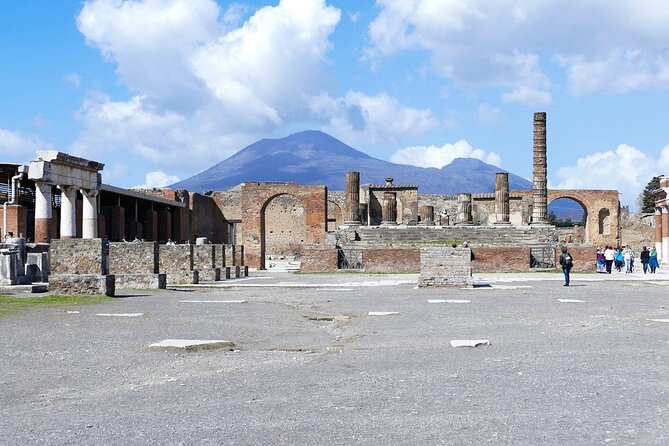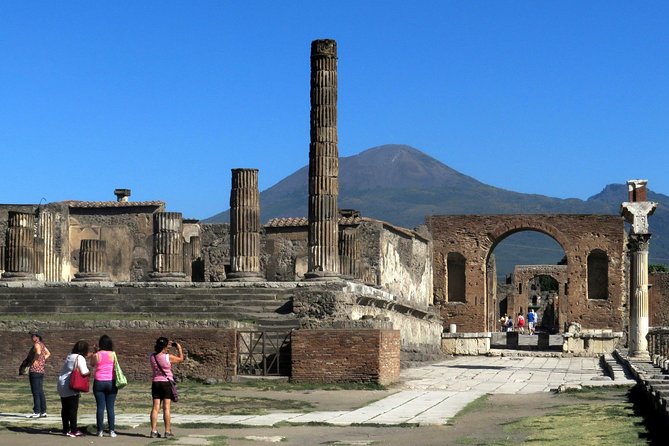Mount Vesuvius also Vesevus or Vesaevus in some Roman sources is a somma-stratovolcano located on the Gulf of Naples in Campania, Italy, about 9 km (5.6 mi) east of Naples and a short distance from the shore. It is one of several volcanoes which form the Campanian volcanic arc. Vesuvius consists of a large cone partially encircled by the steep rim of a summit caldera caused by the collapse of an earlier and originally much higher structure. The eruption of Mount Vesuvius in AD 79 destroyed the Roman cities of Pompeii, Herculaneum, Oplontis and Stabiae, as well as several other settlements. The eruption ejected a cloud of stones, ashes and volcanic gases to a height of 33 km (21 mi), erupting molten rock and pulverized pumice at the rate of 6×105 cubic metres (7.8×105 cu yd) per second, ultimately releasing 100,000 times the thermal energy released by the Hiroshima-Nagasaki bombings. More than 1,000 people died in the eruption, but exact numbers are unknown. The only surviving eyewitness account of the event consists of two letters by Pliny the Younger to the historian Tacitus. Vesuvius has erupted many times since and is the only volcano on the European mainland to have erupted within the last hundred years. Today, it is regarded as one of the most dangerous volcanoes in the world because of the population of 3,000,000 people living near enough to be affected, with 600,000 in the danger zone, making it the most densely populated volcanic region in the world, as well as its tendency towards violent, explosive eruptions of the Plinian type. Vesuvius has a long historic and literary tradition. It was considered a divinity of the Genius type at the time of the eruption of AD 79: it appears under the inscribed name Vesuvius as a serpent in the decorative frescos of many lararia, or household shrines, surviving from Pompeii. An inscription from Capua to IOVI VESVVIO indicates that he was worshipped as a power of Jupiter; that is, Jupiter Vesuvius. The Romans regarded Mount Vesuvius to be devoted to Hercules. The historian Diodorus Siculus relates a tradition that Hercules, in the performance of his labors, passed through the country of nearby Cumae on his way to Sicily and found there a place called "the Phlegraean Plain", "from a hill which anciently vomited out fire ... now called Vesuvius." It was inhabited by bandits, "the sons of the Earth," who were giants. With the assistance of the gods he pacified the region and went on. The facts behind the tradition, if any, remain unknown, as does whether Herculaneum was named after it. An epigram by the poet Martial in 88 AD suggests that both Venus, patroness of Pompeii, and Hercules were worshipped in the region devastated by the eruption of 79.

Mt. Vesuvius (Monte Vesuvio) Tours and Tickets
🎧 Available audio guides (15)
Mount Vesuvius also Vesevus or Vesaevus in some Roman sources is a somma-stratovolcano located on the Gulf of Naples in Campania, Italy, about 9 km (5.6 mi) east of Naples and a short distance from the shore. It is one of several volcanoes which form the Campanian volcanic arc. Vesuvius consists of a large cone partially encircled by the steep rim of a summit caldera caused by the collapse of an earlier and originally much higher structure. The eruption of Mount Vesuvius in AD 79 destroyed the Roman cities of Pompeii, Herculaneum, Oplontis and Stabiae, as well as several other settlements. The eruption ejected a cloud of stones, ashes and volcanic gases to a height of 33 km (21 mi), erupting molten rock and pulverized pumice at the rate of 6×105 cubic metres (7.8×105 cu yd) per second, ultimately releasing 100,000 times the thermal energy released by the Hiroshima-Nagasaki bombings. More than 1,000 people died in the eruption, but exact numbers are unknown. The only surviving eyewitness account of the event consists of two letters by Pliny the Younger to the historian Tacitus. Vesuvius has erupted many times since and is the only volcano on the European mainland to have erupted within the last hundred years. Today, it is regarded as one of the most dangerous volcanoes in the world because of the population of 3,000,000 people living near enough to be affected, with 600,000 in the danger zone, making it the most densely populated volcanic region in the world, as well as its tendency towards violent, explosive eruptions of the Plinian type. Vesuvius has a long historic and literary tradition. It was considered a divinity of the Genius type at the time of the eruption of AD 79: it appears under the inscribed name Vesuvius as a serpent in the decorative frescos of many lararia, or household shrines, surviving from Pompeii. An inscription from Capua to IOVI VESVVIO indicates that he was worshipped as a power of Jupiter; that is, Jupiter Vesuvius. The Romans regarded Mount Vesuvius to be devoted to Hercules. The historian Diodorus Siculus relates a tradition that Hercules, in the performance of his labors, passed through the country of nearby Cumae on his way to Sicily and found there a place called "the Phlegraean Plain", "from a hill which anciently vomited out fire ... now called Vesuvius." It was inhabited by bandits, "the sons of the Earth," who were giants. With the assistance of the gods he pacified the region and went on. The facts behind the tradition, if any, remain unknown, as does whether Herculaneum was named after it. An epigram by the poet Martial in 88 AD suggests that both Venus, patroness of Pompeii, and Hercules were worshipped in the region devastated by the eruption of 79.
Overview
More Info
- Mt. Vesuvius is ideal for both outdoor lovers and history buffs.
- Hiking is best suited for clear days when you can enjoy the views.
- If you plan to hike, wear comfortable walking shoes. The paths are often dusty and rocky, so closed-toe shoes are best.
- You can walk to the edge of the crater only with a certified guide.
More Adventures for You
0$
0$
3000$

Likely to Sell Out
Price From
$153.12 USD
Embark on an enchanting day trip from Rome to explore the ancient ruins of Pompeii and the majestic Mt. Vesuvius. Delve into the UNESCO-listed wonders of Pompeii with a knowledgeable guide and indulge in a delightful 3-course lunch, all while enjoying breathtaking views of the Bay of Naples. Customize your experience by choosing between an exhilarating volcano hike or a more leisurely exploration with a geologist. _en-US
Learn More
Likely to Sell Out
Price From
$125.58 USD
Experience legendary Pompeii and Mt Vesuvius, the only active volcano in continental Europe, on this fully guided day trip from Naples. Visit Pompeii’s haunting ancient ruins, enjoy lunch with your group and then hike to the smoking summit of Mt Vesuvius for panoramic views of the Bay of Naples._en-US
Learn More
Price From
$142.10 USD
Embark on a captivating journey that artfully weaves together history, nature, and adventure. Skip-the-line access to both Pompeii and Vesuvius allows you to make the most of your day. In Pompeii, a 2r guided tour led by an expert archaeologist reveals the haunting beauty of a city frozen in time by the eruption of 79 AD. Following your exploration, indulge in a traditional Italian lunch. Your adventure continues to Mount Vesuvius, with a choice between two unique trails: The Crater Trail leads you on a scenic ascent to the summit, where sweeping views of the Bay of Naples and a striking glimpse into the volcanic crater await. The Valley of Hell offers a more adventurous path, winding through solidified lava flows from the 1944 eruption and revealing extraordinary rock formations and a hidden lava cave. Both trails are led by experienced guides who provide insights into the geological and historical significance of the area. _en-US
Learn More
Price From
$126.68 USD
Spend a full day in the Vesuvian area visiting the archaeological site of Pompeii and Mt. Vesuvius. Departing early in the morning we'll avoid the traffic and crowds ensuring a priority arrival at a destination and a unique experience! With a shared group, you will enjoy a guided tour of Pompeii of 2 hours 30 min and then be taken up to 1000m of Mount Vesuvius, take the last 200m by foot up to the top, here you can stare down into the mouth of the volcano and then take in the breathtaking 360 degree panorama of the surrounding areas._en-US
Learn More
Price From
$125.58 USD
Cruise passengers arriving in the port of Naples can explore legendary Pompeii and Mt Vesuvius, the only active volcano in continental Europe, on this full-day guided tour from Naples. It is a shore excursion not to be missed by any visitor to this region of Italy and includes both a guided tour of Pompeii's haunting ruins and a climb to the smoking summit of volcanic Mt Vesuvius._en-US
Learn More

Access for Seniors
- Access with Portable Ramp
- Recommended time for visit 2 hours
Access for Visually Impaired
- Braille description
- Audio Guide
- Place has Special Guide Service
- Service animals permitted



